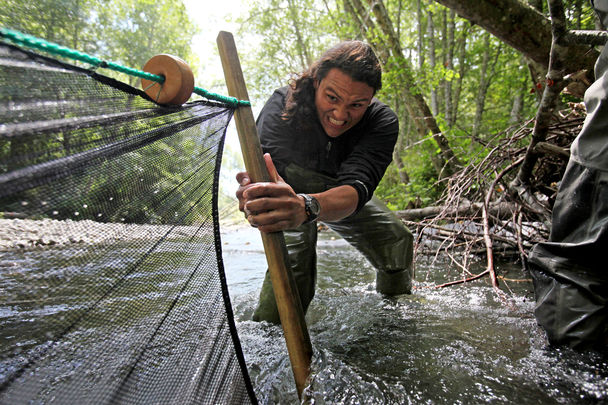
An exhibit based on the Elwha book by Seattle Times’ Lynda Mapes and Steve Ringman opens Saturday at the Burke Museum.
By Keith Ervin, Seattle Times
Chinook salmon returned to the Elwha River this fall in numbers not seen in many decades.
Other creatures have followed the salmon in returning to the Olympic Peninsula valley after an 8-mile stretch of the river was reconnected to saltwater when the Elwha Dam was removed.
A Burke Museum exhibit that opens Saturday tells the story of a river, the people who have depended on it, the scientists who study it, and the changes wrought first by the construction of two dams and now by the biggest dam-removal project in U.S. history.
“Elwha: A River Reborn,” based on the book of the same name by Seattle Times reporter Lynda Mapes and photographer Steve Ringman, runs through March 9.
Mapes will speak, and members of the Lower Elwha Klallam Tribe will talk and perform at the opening of the exhibit, which combines photographs, artifacts from an ancient Klallam village, a million-year-old salmon fossil and hands-on activities.
Children can play the part of a scientist or a journalist in “Camp Elwha,” an interactive exhibit inside a tent.
At the heart of the exhibit is the river, where salmon, steelhead and lampreys lost 70 miles of spawning grounds when dams blocked their passage more than a century ago.
It is also the story of the regeneration that has taken place since the Elwha Dam was removed in 2011 and will continue after demolition of the upstream Glines Canyon Dam is completed next year.
Mapes and Ringman followed the story, first in the pages of this newspaper and then in their 2013 book copublished by Mountaineers Books and The Seattle Times.
“This is a profoundly hopeful story,” said Mapes, who is currently a fellow in the Knight Science Journalism program at MIT.
“It shows that in the right place and with the right conditions, you really do have a chance to start over. You can take a place that’s been used for industrial development, even for a very long time, and have nature come booming back. “
An iconic image for her was a water ouzel in a restored tributary delicately holding a coho salmon egg in its beak “as if it were a glass of fine cabernet.”
George Pess, a NOAA fisheries biologist and a source for Mapes’ reporting, said that as salmon have returned, otters, bears, lampreys and many other animals have come back.
“Everybody kind of got the signal, whether it’s smell or sight, everybody knew something was happening that hadn’t happened in a long time that was important to the ecosystem,” Pess said.
Restoring the salmon to something resembling their once-legendary glory will take years, Pess said.
Bringing back towering trees where lake silt has replaced the humus-rich soil of a long-gone forest, Mapes said, will take much longer.
Although that won’t happen quickly, she said, “One of the things that struck me is how ephemeral the works of man are and how incredibly resilient nature is.”
The exhibit was created by the Burke Museum in collaboration with The Seattle Times, Mountaineers Books and the Lower Elwha Klallam Tribe.
